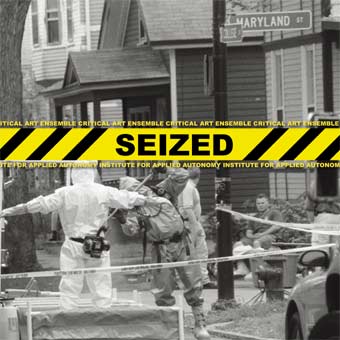 |
|
Art
and Law III FilmScreening/ Round Table: In connection with the exhibition, Art Laboratory Berlin in cooperation with Arsenal - Institute for Film and Video Art e.V. will screen the film Strange Culture (2007) by Lynn Hershmann Leeson on November 2 at 7.30 PM at the Arsenal Cinema, Berlin, followed by a panel discussion. The film documents the events of May 2004 and their aftermath. |
|||||||||||||
|
03.10.2009 - 15.11.2009 Art
and Law III Art
Laboratory Berlin is pleased to announce the exhibition Seized
(October 3 – November 15, 2009) by Critical Art Ensemble (CAE)
and the Institute for Applied Autonomy (IAA) as the third part of
our series Art and Law: |
||||||||||||
|
presents artistic strategies, which try to undercut this. America, country of freedom, was the setting for the events which underlie this exhibition. It shows that it is not self-evident for artists, even in a democracy, to criticize the structures of power and to publicly take a firm stand. The
exhibition SEIZED deals with the FBI raid on the home of CAE member
and art professor Steve Kurtz in Spring 2004 and the four year law
case that followed. In May 2004 Steve’s wife Hope died entirely
unexpectedly because of an undiagnosed heart defect. Emergency responders
from the Fire Department who answered Kurtz’s call saw a chemistry
laboratory, which was part of preparations for an upcoming show,
in the couple’s house. The Fire Department found this suspicious
and informed the FBI. During the three-day-raid the authorities
not only confiscated Kurtz’s computers, archives, artworks
and a set of books he was using for research on his upcoming book
project, but also his wife’s corpse. Steve himself was interrogated
for 22 hours with the aim of charging him with “bioterrorism”
and even murder. Later the charges were changed to to “wire
and mail fraud”, which finally, in 2008, was dropped due to
all evidence of a crime being "insufficient on its face."
In their installation Body of Evidence the artists turn the perpetrator-victim-relationship
upside-down. As the FBI had stolen their artistic material, they,
in return, confiscated the debris left behind on Steve Kurtz’s
lawn by the FBI agents - pizza boxes, Gatorade bottles, hazmat suits
and biological sample bags, as well as written notes and a single
cigar butt. The exhibition’s curators Regine Rapp and Christian
de Lutz write about this in the exhibition catalogue: Critical
Art Ensemble (CAE) is a collective of tactical media practitioners
of various specializations including computer graphics, software,
wetware, film/video, photography, book art and performance. CAE
was founded in 1987 and has produced a wide variety of projects
for an international audience at diverse venues ranging from the
street, to the museum, to the Internet. The
Institute for Applied Autonomy (IAA) was founded in 1998 as
an anonymous collective of engineers, designers, artists and activists
united by the cause of individual and collective self-determination.
Toward this end, the IAA has produced numerous projects under its
flagship initiative, Contestational Robotics. These include several
tele-operated robotic graffiti writers; I-See, which gained worldwide
media attention as a web-based navigation service to help users
avoid surveillance; and Terminal Air, an installation and website
that visualizes the movements of airplanes believed to have been
used in the CIA's "Extraordinary Rendition" program. Strange
Culture documents the surreal nightmare of internationally-acclaimed
artist and professor Steve Kurtz which began when his wife Hope
died in her sleep of heart failure. Police who responded to Kurtz's
911 call deemed Kurtz's art suspicious and called the FBI. Within
hours the artist was detained as a suspected "bioterrorist"
as dozens of federal agents in Hazmat suits sifted through his work
and impounded his computers, manuscripts, books, his cat, and even
his wife's body. The film Strange Culture stars Tilda Swinton, Peter
Coyote, Thomas Jay Ryan, Josh Kornbluth and Steve Kurtz, and was
shown in the 2007 Berlin Film Festival. Catalog:
SEIZED. Critical Art Ensemble & Institute for Applied Autonomy.
Berlin 2009 |
|||||||||||||
| sponsored by: | ||||||
| This exhibition and the catalogue were made possible by an anonymous donor whose wish it is to support projects in the defence of democracy. | ||||||
